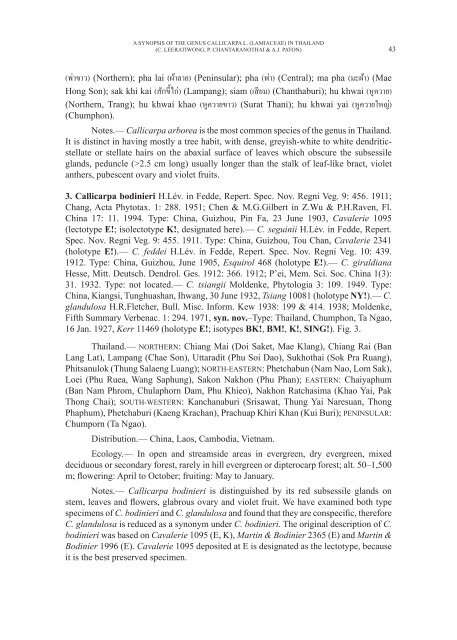You also want an ePaper? Increase the reach of your titles
YUMPU automatically turns print PDFs into web optimized ePapers that Google loves.
A SynOPSIS OF THE GEnUS CALLICARPA L. (LAMIACEAE) In <strong>THAI</strong>LAnD<br />
(C. LEERATIWOnG, P. CHAnTARAnO<strong>THAI</strong> & A.J. PATOn)<br />
(พ่าขาว) (northern); pha lai (ผ้าลาย) (Peninsular); pha (พ่า) (Central); ma pha (มะผ้า) (Mae<br />
Hong Son); sak khi kai (สักขี ้ไก่) (Lampang); siam (เสียม) (Chanthaburi); hu khwai (หูควาย)<br />
(northern, Trang); hu khwai khao (หูควายขาว) (Surat Thani); hu khwai yai (หูควายใหญ่)<br />
(Chumphon).<br />
notes.— Callicarpa arborea is the most common species of the genus in Thailand.<br />
It is distinct in having mostly a tree habit, with dense, greyish-white to white dendriticstellate<br />
or stellate hairs on the abaxial surface of leaves which obscure the subsessile<br />
glands, peduncle (>2.5 cm long) usually longer than the stalk of leaf-like bract, violet<br />
anthers, pubescent ovary and violet fruits.<br />
3. Callicarpa bodinieri H.Lév. in Fedde, Repert. Spec. nov. Regni Veg. 9: 456. 1911;<br />
Chang, Acta Phytotax. 1: 288. 1951; Chen & M.G.Gilbert in Z.Wu & P.H.Raven, Fl.<br />
China 17: 11. 1994. Type: China, Guizhou, Pin Fa, 23 June 1903, Cavalerie 1095<br />
(lectotype E!; isolectotype K!, designated here).— C. seguinii H.Lév. in Fedde, Repert.<br />
Spec. nov. Regni Veg. 9: 455. 1911. Type: China, Guizhou, Tou Chan, Cavalerie 2341<br />
(holotype E!).— C. feddei H.Lév. in Fedde, Repert. Spec. nov. Regni Veg. 10: 439.<br />
1912. Type: China, Guizhou, June 1905, Esquirol 468 (holotype E!).— C. giraldiana<br />
Hesse, Mitt. Deutsch. Dendrol. Ges. 1912: 366. 1912; P’ei, Mem. Sci. Soc. China 1(3):<br />
31. 1932. Type: not located.— C. tsiangii Moldenke, Phytologia 3: 109. 1949. Type:<br />
China, Kiangsi, Tunghuashan, Ihwang, 30 June 1932, Tsiang 10081 (holotype NY!).— C.<br />
glandulosa H.R.Fletcher, Bull. Misc. Inform. Kew 1938: 199 & 414. 1938; Moldenke,<br />
Fifth Summary Verbenac. 1: 294. 1971, syn. nov.–Type: Thailand, Chumphon, Ta ngao,<br />
16 Jan. 1927, Kerr 11469 (holotype E!; isotypes BK!, BM!, K!, SING!). Fig. 3.<br />
Thailand.— nORTHERn: Chiang Mai (Doi Saket, Mae Klang), Chiang Rai (Ban<br />
Lang Lat), Lampang (Chae Son), Uttaradit (Phu Soi Dao), Sukhothai (Sok Pra Ruang),<br />
Phitsanulok (Thung Salaeng Luang); nORTH-EASTERn: Phetchabun (nam nao, Lom Sak),<br />
Loei (Phu Ruea, Wang Saphung), Sakon nakhon (Phu Phan); EASTERn: Chaiyaphum<br />
(Ban nam Phrom, Chulaphorn Dam, Phu Khieo), nakhon Ratchasima (Khao yai, Pak<br />
Thong Chai); SOUTH-WESTERn: Kanchanaburi (Srisawat, Thung yai naresuan, Thong<br />
Phaphum), Phetchaburi (Kaeng Krachan), Prachuap Khiri Khan (Kui Buri); PEnInSULAR:<br />
Chumporn (Ta ngao).<br />
Distribution.— China, Laos, Cambodia, Vietnam.<br />
Ecology.— In open and streamside areas in evergreen, dry evergreen, mixed<br />
deciduous or secondary forest, rarely in hill evergreen or dipterocarp forest; alt. 50–1,500<br />
m; flowering: April to October; fruiting: May to January.<br />
notes.— Callicarpa bodinieri is distinguished by its red subsessile glands on<br />
stem, leaves and flowers, glabrous ovary and violet fruit. We have examined both type<br />
specimens of C. bodinieri and C. glandulosa and found that they are conspecific, therefore<br />
C. glandulosa is reduced as a synonym under C. bodinieri. The original description of C.<br />
bodinieri was based on Cavalerie 1095 (E, K), Martin & Bodinier 2365 (E) and Martin &<br />
Bodinier 1996 (E). Cavalerie 1095 deposited at E is designated as the lectotype, because<br />
it is the best preserved specimen.<br />
43
















